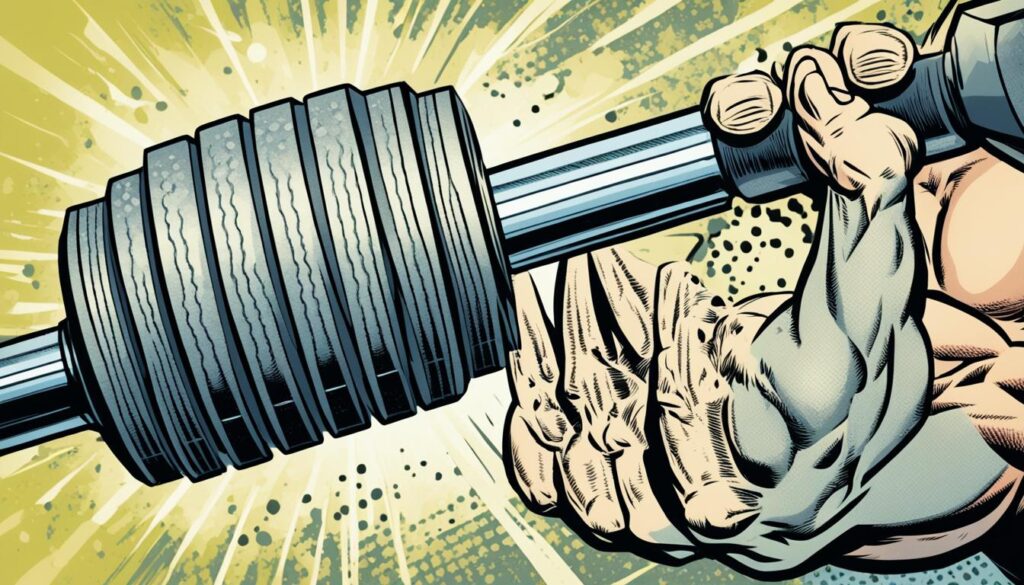The Art of bench press grip
The bench press is a staple exercise in any strength training routine, and mastering your bench press grip is crucial for maximizing muscle development and overall performance. Whether you’re a seasoned lifter or just starting out, understanding the nuances of grip technique can make a significant difference in your workout results.
Key Takeaways:
- A proper bench press grip plays a vital role in muscle development.
- Mastering different grip variations can enhance your form and engage various muscle groups.
- Using the correct grip technique helps prevent injuries and maintain long-term joint health.
- Dumbbells can be a valuable tool for improving grip strength and stability.
- Perfecting your bench press grip takes practice and attention to detail, but the results are worth it.
Understanding Bench Press Grip Variations
When it comes to the bench press, the grip you choose can have a significant impact on your form, muscle engagement, and overall workout effectiveness. By understanding the different variations of bench press grips, you can optimize your training routine and achieve better results.
There are several grip variations commonly used in bench press exercises, including the conventional grip, the wide grip, the close grip, and the reverse grip.
“Choosing the right grip variation is crucial for targeting specific muscle groups, optimizing power production, and reducing the risk of injury.”
The conventional grip is the most common grip used in bench press. In this grip, your hands are positioned slightly wider than shoulder-width apart, with palms facing away from your body. This grip allows for balanced muscle activation in the chest, shoulders, and triceps.
The wide grip involves placing your hands wider than shoulder-width apart, increasing the range of motion and targeting the outer chest muscles. However, it may put more stress on the shoulder joints, so it’s essential to maintain proper form and avoid excessive weight.
The close grip, on the other hand, requires placing your hands closer together than in the conventional grip. This grip primarily targets the triceps, enabling greater muscle activation in the back of the arms. It can also enhance stability and support in heavy lifts.
Lastly, the reverse grip is less common but can be beneficial for targeting the upper chest and engaging the biceps more effectively. In this grip, your palms face towards your body instead of away. It’s crucial to practice caution and gradually increase the weight with this grip variation due to the increased strain on the wrists.
The Impact of Grip Variations
The choice of bench press grip can affect the movement pattern and muscle recruitment during the exercise.
A wider grip may involve a greater range of motion and put more emphasis on the pectoral muscles. However, it can also increase the risk of shoulder impingement if not performed with proper technique.
On the other hand, a close grip can shift the targeted muscles towards the triceps, allowing for greater strength and size development in the back of the arms. It can also provide stability and control throughout the movement.
Experimenting with different grip variations in your training routine can help target specific muscle groups, enhance overall muscle engagement, and prevent plateaus in your progress.
| Grip Variation | Primary Muscles Targeted | Benefits |
|---|---|---|
| Conventional Grip | Chest, Shoulders, Triceps | Balanced muscle activation |
| Wide Grip | Outer Chest | Increased range of motion |
| Close Grip | Triceps | Enhanced stability and tricep activation |
| Reverse Grip | Upper Chest, Biceps | Targeting different muscle groups |
Keep in mind that individual differences and goals will play a role in determining the most suitable grip variation for you. It’s important to listen to your body and consult with a qualified fitness professional if needed.
The Benefits of Proper Bench Press Grip Technique
Using the correct bench press grip technique can have a significant impact on your workout routine, enhancing muscle activation, preventing injuries, and allowing you to target different muscle groups effectively.
“Proper bench press grip is essential for maximizing your muscle development and achieving optimal results. It not only improves your form and technique but also minimizes the risk of strain or injury.”
One of the key benefits of using the right bench press grip is enhanced muscle activation. By gripping the bar correctly and engaging the muscles in your hands, forearms, and upper body, you can ensure that the targeted muscles, such as the chest, shoulders, and triceps, are effectively activated during the exercise.
Additionally, using the proper grip technique can help prevent injuries. A secure grip reduces the chances of the bar slipping or rolling out of your hands, minimizing the risk of accidents or dropping heavy weights onto yourself. By maintaining control over the bar throughout the movement, you can train with confidence and minimize the potential for mishaps.
Another advantage of mastering various bench press grip techniques is the ability to incorporate different muscle groups into your routine. By adjusting your grip width, hand placement, or angle, you can shift the emphasis of the exercise onto specific muscle groups. For example, a wider grip may activate the chest muscles more, while a closer grip may engage the triceps to a greater extent.
Optimizing Your Grip for Maximum Muscle Engagement
To ensure you’re getting the most out of your bench press grip, consider the following tips:
- Experiment with different grip widths to find the variation that best targets your desired muscle group.
- Place your hands shoulder-width apart or slightly wider to engage the chest muscles effectively.
- Keep your wrists aligned with your forearms to maintain proper form and minimize wrist strain.
- Focus on squeezing the bar tightly throughout the exercise to maximize grip strength and control.
Remember, mastering the bench press grip technique takes practice and patience. Start with lighter weights and gradually increase the load as you become more comfortable and confident in your grip strength.
By prioritizing proper bench press grip technique, you can unlock the full potential of your muscles and elevate your workout routine to new heights.
Perfecting Your Bench Press Grip
When it comes to the bench press, your grip plays a crucial role in ensuring proper form and maximizing your strength. In this section, I’ll share techniques and tips to help you perfect your bench press grip and elevate your performance.
Grip Width
One key aspect of a solid bench press grip is determining the optimal width for your hands. Generally, a shoulder-width grip is a good starting point for most individuals. However, you may find that adjusting your grip slightly wider or narrower feels more comfortable and allows for better muscle engagement.
Hand Placement
Equally important as grip width is hand placement on the bar. When grabbing the bar, aim to position your hands evenly, ensuring they are centered and balanced. Placing your hands too far forward or backward can throw off your balance and negatively impact your form.
Wrist Alignment
To maintain proper wrist alignment, it’s essential to avoid excessive bending or extension during the bench press. Aim to keep your wrists in a neutral position, aligned with your forearms. This alignment will help distribute the weight evenly and reduce the risk of injuries.
The Role of Dumbbells
Incorporating dumbbells into your bench press routine can significantly enhance your grip strength. Grabbing dumbbells instead of a barbell challenges your grip stability as each dumbbell demands independent control. Plus, the grip required for dumbbells varies slightly from a traditional barbell grip, helping you develop a well-rounded grip strength.

By perfecting your bench press grip, you can improve muscle engagement, increase your lifting capacity, and reduce the risk of injuries. Experiment with different grip widths, hand placements, and incorporate dumbbells into your training to challenge your grip strength further. Remember to always listen to your body and adjust your grip as necessary for optimal performance.
Conclusion
In conclusion, the bench press grip is a crucial element in maximizing your performance and muscle development during your workouts. By understanding the different grip variations, benefits, and techniques, you can optimize your bench press routine and achieve your fitness goals more effectively.
A proper bench press grip allows for greater muscle activation and engagement, leading to improved strength and hypertrophy. Whether you prefer a wide grip, narrow grip, or neutral grip, each variation targets distinct muscle groups, providing a well-rounded workout for your upper body.
Furthermore, using the correct bench press grip technique enables better control, stability, and injury prevention. It ensures that your wrists, elbows, and shoulders are properly aligned, reducing the risk of strain or discomfort that could hinder your progress. The right grip also allows you to generate more power and transfer it efficiently through your body, resulting in better overall performance.
To perfect your bench press grip, practice with dumbbells to enhance your grip strength and stability. Experiment with different hand placements, width variations, and angles to find the grip that feels most comfortable and effective for you. Remember to listen to your body and adjust accordingly to avoid excessive strain or discomfort.
FAQ
Why is the bench press grip important in my workout routine?
The bench press grip is crucial because it determines how effectively you engage your muscles during the exercise. Having the correct grip allows for proper muscle activation and development.
What are the different variations of bench press grip?
There are several variations of bench press grip, including the standard grip, close grip, wide grip, and neutral grip. Each variation targets different muscle groups and can impact your form and overall workout effectiveness.
What are the benefits of using proper bench press grip technique?
Using proper bench press grip technique has several benefits. It helps to activate and engage the targeted muscles more effectively, reduces the risk of injury, and allows you to incorporate different muscle groups into your routine for a more balanced workout.
How can I perfect my bench press grip?
To perfect your bench press grip, focus on grip width, hand placement, and wrist alignment. Experiment with different grip variations to find the one that feels the most comfortable and allows for optimal muscle engagement. Additionally, incorporating dumbbell exercises into your routine can help improve your grip strength.
What is the significance of a proper bench press grip in muscle development?
A proper bench press grip is vital for muscle development as it ensures that the targeted muscles are being engaged fully. By using the correct grip, you can optimize the activation of specific muscle groups, leading to better muscle growth and overall strength gains.
